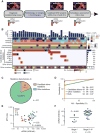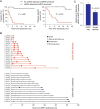Early Detection of Molecular Residual Disease in Localized Lung Cancer by Circulating Tumor DNA Profiling
- PMID: 28899864
- PMCID: PMC5895851
- DOI: 10.1158/2159-8290.CD-17-0716
Early Detection of Molecular Residual Disease in Localized Lung Cancer by Circulating Tumor DNA Profiling
Abstract
Identifying molecular residual disease (MRD) after treatment of localized lung cancer could facilitate early intervention and personalization of adjuvant therapies. Here, we apply cancer personalized profiling by deep sequencing (CAPP-seq) circulating tumor DNA (ctDNA) analysis to 255 samples from 40 patients treated with curative intent for stage I-III lung cancer and 54 healthy adults. In 94% of evaluable patients experiencing recurrence, ctDNA was detectable in the first posttreatment blood sample, indicating reliable identification of MRD. Posttreatment ctDNA detection preceded radiographic progression in 72% of patients by a median of 5.2 months, and 53% of patients harbored ctDNA mutation profiles associated with favorable responses to tyrosine kinase inhibitors or immune checkpoint blockade. Collectively, these results indicate that ctDNA MRD in patients with lung cancer can be accurately detected using CAPP-seq and may allow personalized adjuvant treatment while disease burden is lowest.Significance: This study shows that ctDNA analysis can robustly identify posttreatment MRD in patients with localized lung cancer, identifying residual/recurrent disease earlier than standard-of-care radiologic imaging, and thus could facilitate personalized adjuvant treatment at early time points when disease burden is lowest. Cancer Discov; 7(12); 1394-403. ©2017 AACR.See related commentary by Comino-Mendez and Turner, p. 1368This article is highlighted in the In This Issue feature, p. 1355.
©2017 American Association for Cancer Research.
Conflict of interest statement
No potential conflicts of interest were disclosed by the other authors.
Figures




Comment in
-
Predicting Relapse with Circulating Tumor DNA Analysis in Lung Cancer.Cancer Discov. 2017 Dec;7(12):1368-1370. doi: 10.1158/2159-8290.CD-17-1086. Cancer Discov. 2017. PMID: 29208774
References
-
- Ettinger DS, Wood DE, Aisner DL, Akerley W, Bauman J, Chirieac LR, et al. Non-Small Cell Lung Cancer, Version 5.2017, NCCN ClinicalPractice Guidelines in Oncology. J Natl Compr Canc Netw. 2017;15:504–35. - PubMed
-
- Kocak Z, Evans ES, Zhou SM, Miller KL, Folz RJ, Shafman TD, et al. Challenges in defining radiation pneumonitis in patients with lung cancer. Int J Radiat Oncol Biol Phys. 2005;62:635–8. - PubMed
-
- Huang K, Dahele M, Senan S, Guckenberger M, Rodrigues GB, Ward A, et al. Radiographic changes after lung stereotactic ablative radiotherapy (SABR)–can we distinguish recurrence from fibrosis? A systematic review of the literature. Radiother Oncol. 2012;102:335–42. - PubMed
-
- Hung JJ, Hsu WH, Hsieh CC, Huang BS, Huang MH, Liu JS, et al. Post-recurrence survival in completely resected stage I non-small cell lung cancer with local recurrence. Thorax. 2009;64:192–6. - PubMed
MeSH terms
Substances
Grants and funding
LinkOut - more resources
Full Text Sources
Other Literature Sources
Medical

